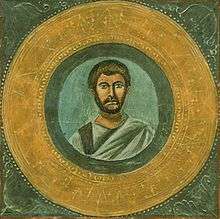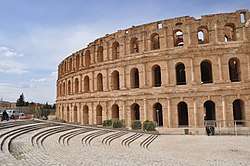Roman Africans
Roman-Africans (Latin: Afri ; Arabic: Afariqa) were the ancient Northwest African populations of Roman North Africa that had a Romanized culture and used to speak their own variety of Latin as a result.[1] They existed mostly from the Roman conquest in the antiquity until their language gradually faded out after the Arab conquest of North Africa in the Early Middle Ages (approximately the 8th century AD).
Afri (Latin) Afariqa (Arabic) | |
|---|---|
 Portrait of the Roman African poet Terentius | |
| Regions with significant populations | |
| North Africa (today's | |
| Languages | |
| Latin (Commonly spoken in its own regional variety) Berber and Punic Maghrebi Arabic (as a result of language shift) | |
| Religion | |
| Roman religion Christianity (Roman Catholicism and Donatism) | |
| Related ethnic groups | |
| Berbers, Punics and Maghrebis |
Roman Africans lived in all the coastal cities of contemporary Tunisia, Western Libya and Eastern Algeria. This area became known under Arab rule as Ifriqiya, an Arabized version of the name of the Roman province of Africa.
The Roman Africans were generally local Berbers or Punics, but also the descendants of the populations that came directly from Rome itself or the diverse regions of the Empire as legionaries and senators.
Language
Characteristics
The Roman-Africans first adopted the Roman pantheon under the rule of the Roman Republic, but then were one of the first provinces to convert to Christianity and among their most known figures we can mention Saint Felicita, Saint Perpetua, Saint Cyprian and Saint Augustine. Contrarily to the so-called Mauri that mostly inhabited the westernmost part of Northwest Africa and were barely romanised, Roman Africans (like Septimus Severus or the saint Aurelius Augustinus) had Latin names in addition to speaking Latin.

The African province was amongst the wealthiest regions in the Empire (rivaled only by Egypt, Syria and Italy itself) and as a consequence people from all over the Empire migrated into the province. Large numbers of Roman Army veterans settled in Northwest Africa on farming plots promised for their military service.
Even so, the Roman military presence of Northwest Africa was relatively small, consisting of about 28,000 troops and auxiliaries in Numidia. Starting in the 2nd century AD, these garrisons were manned mostly by local inhabitants. A sizable Latin speaking population developed from a multinational background, sharing the northwest African region with those speaking Punic and Berber languages.[2][3] Imperial security forces began to be drawn from the local population, including the Berbers.
By the end of the Western Roman Empire nearly all of the African province was fully romanised, according to Theodor Mommsen in his The Provinces of the Roman Empire. Roman Africans enjoyed a high level of prosperity. Such prosperity (and romanisation) touched partially even the populations living outside of the Roman limes (mainly the Garamantes and the Getuli).
The Roman African populations kept their Latin language, as well as their Catholic Christian religion, under the Germanic Vandal occupation, the Byzantine restoration and the Islamic conquest, where they progressively converted to Islam until the extinction of Christianity in the Maghreb in the 12th century under the Almohads. The African Romance Latin dialect constituted a significant substratum of the modern varieties of the Berber languages and Maghrebi Arabic.[4][5]
The Muslim conquerors indeed distinguished in the 7th century three distinct categories of populations in Northwest Africa: the foreign population from Rūm (Byzantium), mainly composing the military and administrative elite, who generally spoke Greek (From Byzacena); the Afāriqah: the Roman Africans, the native Latin-speaking community mostly concentrated in the urban areas; and finally the Barbar ( بربر ): that is, the Berber farmers that populated most of the rural countryside.[6]
The willing acceptance of Roman citizenship by members of the ruling class in African cities produced such Roman Africans as the comic poet Terence, the rhetorician Fronto of Cirta, the jurist Salvius Julianus of Hadrumetum, the novelist Apuleius of Madauros, the emperor Septimius Severus of Lepcis Magna, the Christians Tertullian and Cyprian of Carthage, and Arnobius of Sicca and his pupil Lactantius; the angelic doctor Augustine of Thagaste, the epigrammatist Luxorius of Vandal Carthage, and perhaps the biographer Suetonius, and the poet Dracontius.
— Paul MacKendrick, The North African Stones Speak (1969), UNC Press, 2000, p.326
See also
- African Romance
- Roman Africa (disambiguation)
- Roman colonies in Berber Africa
References
- Gilbert Meynier, l'Algérie des origines : de la préhistoire à l'avènement de l'islam éditions La Découverte, 2007, à partir de la page 65, chapitre : sous la domination romaine : les Romano-Africains
- Abun-Nasr, A History of the Maghrib (1970, 1977) at 35-37.
- Laroui challenges the accepted view of the prevalence of the Latin language, in his The History of the Maghrib (1970, 1977) at 45-46.
- (in French) Tilmatine Mohand, Substrat et convergences: Le berbére et l'arabe nord-africain (1999), in Estudios de dialectologia norteafricana y andalusi 4, pp 99–119
- Corriente, F. (1992). Árabe andalusí y lenguas romances. Fundación MAPFRE.
- The muslim conquest and settlement of North Africa and Spain, Abdulwahid Thanun Taha, Routledge Library Edition: Muslim Spain p21
Bibliography
- Gibbon. Edward Decline and Fall of the Roman Empire (1888)
- Southern, Pat. The Roman Empire from Severus to Constantine Routledge. London, 2001